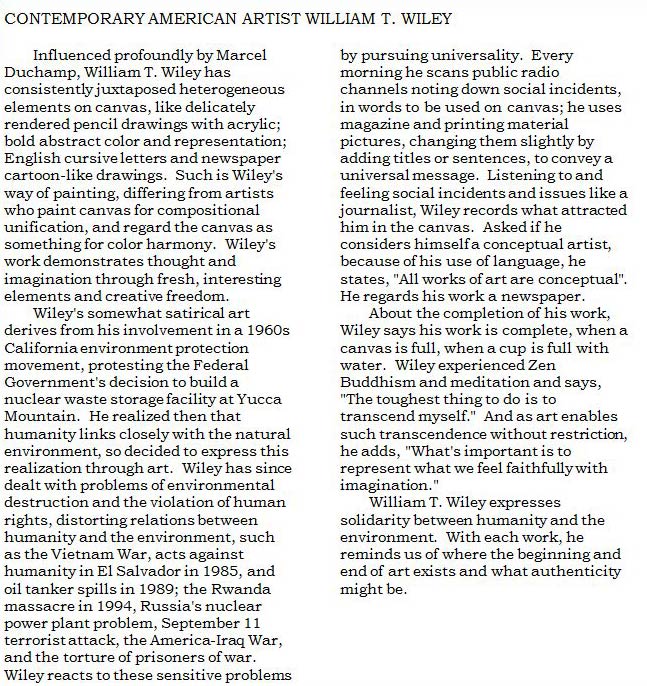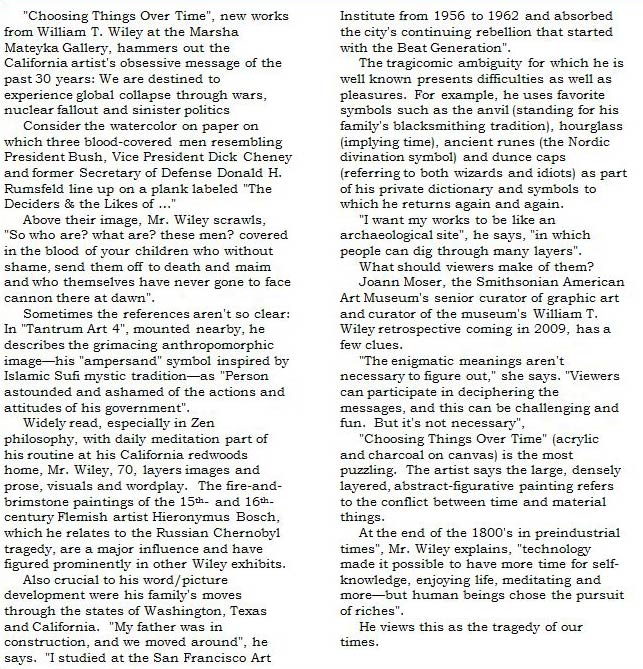William T. Wiley
Smithsonian American Art Museum
by David Anfam
Artforum, February 2010, p 207

If American culture had to be grouped into two camps, what neater divide could there be than between idealists and pragmatists? The Pilgrim fathers, Emersons and Clyfford Stills of this world would then square off against the Ben Franklins, Hemingways and Rauschenbergs. Of course, reality can't be pigeonholed so easily. Indeed, the going gets tough, and most interesting, when such opposites intersect. Mergers of this kind are evident throughout William T. Wiley's art, and their aesthetic consequences may help explain his relative neglect since the 1980s. The current retrospective recuperates Wiley, revealing a visionary, albeit often wayward, figure. Like many visionaries, he has been both ahead of his time and at odds with it.
Wiley may pose difficulties for some critics because unlike most "ideas" artists—from Duchamp to Damien Hirst—he is an obsessively skillful draftsman and painter. "Columbus Rerouted #1", 1961, which appeared at the Smithsonian exhibition's outset, showed how quickly Wiley had mastered Bay Area Abstract Expressionism, adding his own twists. The theme of voyaging, evident in this big canvas's cartoonish cartography and title, would recur throughout his career. Likewise, the heterodox motifs—forms reminiscent of sails, a measuring rod, lightning, and so forth—anticipated Wiley's taste for assemblage. Within a few years, he was making quizzical constructions, such as the chairlike "Slant Step Becomes Rhino/Rhino Becomes Slant Step", 1966, and implanting words into these and their painted counterparts. "Shark's Dream", 1967, pictures an industrial-looking shaft, seemingly strayed from the realm of "primary objects," dreaming of itself reversed in a thought balloon, with the title inscribed below. Here Wiley announced another major concern: language's maze—reversals (as in spoonerisms), homonyms, puns and so forth. Scant surprise that Bruce Nauman was Wiley's student at the University of California, Davis, and that the two became lifelong friends. Nauman rose to lasting fame; Wiley resisted the various passing isms.
By the early '70s, Wiley had found his stride. Diverse paintings, constructions, artists' books, prints, film, and more proved that no medium escaped his reach. Perhaps fatally for Wiley's reception, though he also began to favor smallish watercolors. Watercolor just wasn't the hip thing for the era of Minimalism, Conceptualism, Land art, video, and othe new media, and the choice may have cost him much in terms of critical acclaim. Nevertheless, watercolor on paper was the perfect nexus where Wiley could fuse his artisanal miniaturists' touch with linguistic fireworks. After all, paper is the quintessential vehicle for words. To rephrase Wittgenstein's famous aphorism, the limits of Wiley's imagination look as endless as the possibilities of language itself. In an excellent catalogue essay, poet and critic Joh Yau explores the implications of the artist's manipulation of speech and seeing.
Certainly, it's easy to unravel Wiley's touchstones. They have ranged from Edwad Kienholz, Jess, R. Crumb and Jasper Johns (not to mention sly swipes a Greenbergian Formalists) to Bosch and Ensor—the latter two, like Wiley, were caustic and minutely detailed observers of human folly. However, the final mix feels altogether singular. Not only has the artist's long-standing concern for ecology predated the intensity of today's fashions by decades, but "What's It All Mean: William Wiley in Retrospect" provides some uncanny parallels with and flashes forward to European developments—among them, Anselm Kiefer's convoluted mythological zones, Sigmar Polke's anti stylistic hybridization, and even Jonas Burgert's blend of gothic and carnivalesque. Echoing a long tradition of American oddballs who merge the mind's ludic spaces with reality's pithy jumble—witness Whitman, Ives, Cornell, Saul Steinberg, Thomas Pynchon, and others—Wiley offers a remarkable artistic exemplar of the kind of metaphysical and moral masquerade epitomized in an earlier century by Herman Melville's, well, wily Confidence-Man.
He's Wiley, And Witty
by Sidney Lawrence
The Wall Street Journal, December 12, 2009, p. 13
 Washington
Washington During the 1970s in New York, artists working in the West Coast and Chicago—including H.C. Westermann, Robert Arneson, Robert Colescott and Peter Saul—raised hackles and gained fans for their cartoonish, jittery and emotionally direct works loaded with offbeat materials and associations.
Among this group was a slightly younger artist from northern California, William T. Wiley, who was being noticed for his skillfully drawn, pun-loaded and casually enigmatic work, often subverting modernism's language of geometric abstraction and assemblage with a glut of personal meaning. Already credentialed by exhibitions in his home state, as well as Chicago, Paris, Milan, the Netherlands and Germany, this "Huckleberry Duchamp," as an Art News reviewer called him in 1974, soon emerged as a national figure.
In 1979-80, the Walker Art Center in Minneapolis toured Mr. Wiley's first major retrospective to six U.S. cities, but no East Coast museum participated. Now, three decades later, the Smithsonian American Art Museum in Washington is offering Mr. Wiley's second career survey, "What's it All Mean: William T. Wiley in Retrospect" Presenting nearly 90 paintings, works on paper, mixed-media assemblages and sculptures, plus early film clips, this exhibition created by the museum's Joann Moser continues through Jan. 24 before traveling to Berkeley, California.
The question asked in the show's title—his own word from a palette-shaped sign that starts the presentation—couldn't be more apt. Life is a never-ending Mobius-strip; don't look for meaning; go with the flow, Mr. Wiley's works seem to say. His art can be friendly and offputting, skillful and rough, funny and serious, as confounding as Dada and as soothing as Zen.
One of the show's many jewel-like watercolors with ink, "Hide as a State of Mind" (1971), is a case in point. The letters H-I-D-E appear as dried-out animal hides in a rocky landscape with bits of flickering coastline. Tipped-up like a Chinese scroll, the composition resembles a map of the U.S. bisected by a black-and-white striped "range pole" (a surveyor's instrument used by the artist's father and a favorite motif ). The "West" has grassy and earthen colors; the "East" is a frozen tundra. A Squaw-like 1930's-cartoon character below exclaims, "God only knows what we are ex---ing." Expecting? Exporting? Exploring? Exploding? Her head and arms create illegibility. But no problem as we linger to unlock a theme (maybe) of American cultural conflict.
For every Wiley that puzzles a viewer, there's another that invites recognition and laughter. The punning "Working Under the Trance Sum" (1979), a 5 foot by 7 foot drawing in pencil and charcoal, pairs Mr. Wiley's versions of two 19th-century gentlemen's portraits by Eastman Johnson and James McNeil Whistler in atmospheric interiors. Art-School clichés appear in a transom: "Trust your spirit", "never use the color black" and "Yeah you crook you stole my ideas."
If there's any doubt that Mr. Wiley, now 72, has a personality all his own, nearby self-portraits on paper should shatter it. "Mr Unatural [sic]," a persona Mr. Wiley developed in 1975 in response to underground cartoonist R. Crumb's "Mr. Natural", is a skinny figure with a robe wearing Japanese wood sandals, a conical dunce cap and a rubber nose. Part Venetian carnival figure, part Medieval wizard, part Buddhist monk, he has anxiety fits here, sits serenely in a throne there, and poses like a nerdy "David" elsewhere. These theatrical works open a window into Mr. Wiley's quirky magnetism.
His inner life is the subject of 1982's "In the Name of (Not to Worry It's Juxtaposition)." On a 9-by-10 canvas, layers of charcoal, ink and black felt-tip lines conjure the Giacometti-skinny artist relaxing in a barnlike studio amid personal prop and musings-a mummy-model on a bed, a text decrying nuclear waste, a giant snail on a stool and so on. A blazing diagonal of checkerboard colors pierces this monochrome universe from above, like a bolt of inspiration, producing an effect that a one-time denizen of San Francisco's hippie culture, Sarah Burns, now a respected art historian, has likened to "Acid cut with speed" To bring further astonishment, a found-object stick figure in the drawing rematerializes as a mixed-media assemblage to the right, the piece's second element.
After such operatically abstract, self-revealing works, Mr. Wiley's borrowings from Old Master, Medieval and other pictorial sources in the 1990s take some getting used to. More paint, less drawing and topical subjects are the keynotes here. In one 1994 painting, a burning village from Hieronymus Bosch's "Temptation of St. Anthony"" (c.1550) becomes Mr. Wiley's starting point with various writings and vignettes, for a look into Chernobyls' grisly legacy. In a 1998 work, he melds Pieter Bruegel the Elder's intricate "Tower Of Babel" ( 1563) with a steely Mesopotamian ziggurat full of puzzling ideograms and inscriptions.
"Sold Yours Return" (2005) is about the war in Iraq. A serviceman with a hook hand and prosthetic leg enters an idyllic farmyard. Snaking paint, a cartoon bubble, splats of black and a grid enliven the brownish depiction based on a World War II illustration by N.C. Wyeth. Lacking Mr. Wiley's usual manic intensity, the work seems tame and literal.
Has Mr. Wiley lost his sense of humor ? Hardly. In another 2005 work, a new keep-on-truckin' persona, "Seedy Rom," gingerly walks beside a river carrying canvases. And who can resist Mr. Wiley's "punball" machine, with its cartoonish personages and implied metaphors for winning and losing in life? He played this cultural artifact at the press preview. The machine went tilt.
Even when not 100% successful, Mr. Wiley's work is unlike any other in recent art, a visual analog to the stream-of-consciousness strain in 20th-centure literature. Likening Mr. Wiley to Virginia Woolf or James Joyce is dicey, of course, but his swirling cornucopias of images, works and associations are every bit as intoxicating, operating beyond their medium, in the subconscious. He is less a contemporary artist than a national treasure.
Mr. Lawrence is an artist and writer in Washington.





